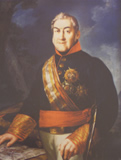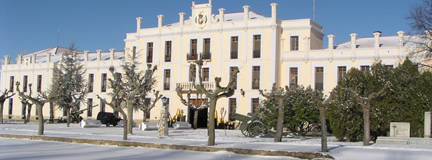MENÚ UNIDAD
ARMY UNITS
- Araba Álava |
- Albacete |
- Alicante |
- Almería |
- Asturias |
- Ávila |
- Badajoz |
- Barcelona |
- Burgos |
- Cáceres |
- Cádiz |
- Cantabria |
- Castellón |
- Ceuta |
- Ciudad Real |
- Córdoba |
- A Coruña |
- Cuenca |
- Girona |
- Granada |
- Guadalajara |
- Gipuzkoa |
- Huelva |
- Huesca |
- Islas Baleares |
- Jaén |
- León |
- Lleida |
- Lugo |
- Madrid |
- Málaga |
- Melilla |
- Murcia |
- Navarra |
- Ourense |
- Palencia |
- Las Palmas |
- Pontevedra |
- La Rioja |
- Salamanca |
- Segovia |
- Sevilla |
- Soria |
- Tarragona |
- Santa Cruz de Tenerife |
- Teruel |
- Toledo |
- Valencia |
- Valladolid |
- Bizkaia |
- Zamora |
- Zaragoza

Background
- pagination
-
Military Record of the 63rd RALCA
On December 31, 2015, as a consequence of the Transition Plan for New Structures in the Army, the new 63rd Field Rocket Launcher Artillery Regiment was activated at the Santocildes base, merging the 63rd RACA (León) and 62nd RALCA (Astorga) that were removed from the Army’s current organization.
It is comprised of:
· HQ/63
· GALCA 1/63
· GAIL 2/63
The Regiment command, its HQ and 1/63 GALCA are located within the Santocildes base, facilities built between 1921 and 1925, as per Royal Order of December 21st, 1920, on soil donated by the Astorga City Council. 2/63 GAIL is located at the “Conde de Gazola” base, in San Andrés del Rabanedo, in the former facilities of the 63rd RACA.
The following military records provide the details of its history…
-
Military Record of the 62nd RALCA
In 1925, the base housed military units for the very first time, specifically the 77th Infantry Regiment “Órdenes Militares”, which merged, in 1931, with the 36th Infantry Regiment “Burgos” and whose 1st Battalion was stationed at Astorga.
During the period 1931 to 1939, several events, especially the Civil War, decided the future of the Base, which was used as a troop depot and a military jail.
In 1939, the 27th Artillery Regiment, which was comprised of nine batteries from several combat fronts, is activated and located in the Base under the command of Cavalry Colonel José Sánchez and with 75/28 and 105/11 guns.
Between 1941 and 1949, the Regiment was reorganized several times and its assets were modernized. In 1949, the 36th Infantry Regiment “Burgos” left Astorga due to space constraints and moved to Tabor (Expeditionary Company of the 1st Indigenous Regular Infantry Forces Group of Ceuta).
As per General Instruction No. 160-115, dated January 15th, 1960, of the Central General Staff of the Army, the Regiment became a Rocket Launcher Artillery Regiment and received its first rocket launchers C, E and D by the end of that year.
In 1965, General Instruction No. 165-142, dated July 10th, 1965, of the General Staff of the Army, changed the name of the unit, which became the Field Artillery Rocket Launcher Regiment, and joined the Artillery Brigade with its Commander and Headquarters in Burgos. Its materiel was comprised of rocket launchers E, C and G.
In 1966, the Regiment, with its new denomination of RALCA, joined the Army Corps Artillery Brigade (BRARTCE) headquartered at Burgos.
General Instruction 4/88 on General Reserve organization, dated April 14th, 1988, of the General Staff of the Army (5th Division) ordered it to join the General Reserve Field Artillery Command (MACA), with the denomination of 62ndField Artillery Rocket Launcher Regiment (RALCA 62). It consisted of three TERUEL Rocket Launcher groups.
On October 1st, 1995, General Regulation 8/94 reorganized the groups of the RALCA 62. RALCA 62 was then comprised of GALCA 1/62 (TERUEL rocket launcher system) and GACA 2/62 (155/23 guns).
In 1998, the regiment activated the Model Unit (UNIMOD), with the aim of collaborating in the development of the 155/52 gun.
In September 1998, a platoon of the Regiment joined the MNHQSU 2003 Bosnia as part of the 21st SPAGT until May of 2004. Other deployments abroad include: 24th SPAGT (Bosnia and Herzegovina in 2005), 21st and 23rd KSPAGT (Republic of Serbia-Kosovo in 2008 and 2009) and 28th ASPFOR (Afghanistan in 2011).
In 2008, GACA 2/62 was disbanded when its 155/23 guns reached the end of their service life but at the same time, the Target Engagement Battery was created with anti-mortar radar AN/TPQ-36 assets and one Sound Localization System SORAS-6.
In October 2011, six guns of the new 155/52 Tubia SIAC arrived and in December 2011, the emblematic LCM-40 Teruel was deregistered from the Army inventory. The GALCA 1/62 was responsible for receiving the new guns from the Teruel system.
Gradually, the 62nd RALCA received new 155/52 guns and the Transition Plan for New Structures in the Army ordered the 62nd RALCA to be disbanded as a unit in the Army in December of 2015.
-
Military Record of the 63rd RACA
It was activated by Royal Decree of May 1st, 1875 – although its real organization dates to July 1st of said year. It was named the 6th Mounted Regiment and consisted of four companies, one from each Mounted Regiment then existing in Spain.
By Royal Decree of May 3rd, 1875, this 6th Regiment was ordered to be based at Burgos and from that moment the companies of the Mounted and Mountain Regiments were called Batteries.
Its first Colonel was Joaquín Ceballos Escalera.
On December 26th, 1884, the Artillery Branch was reorganized and the Regiment took the name 3rd Battle Regiment of the Army Corps.
By Royal Decree of February 10th, 1893, it took the name 3rd MOUNTED REGIMENT.
Royal Order of August 17th, 1918, which developed the law of June 29th, applying the changes in the Branch enacted by Minister DE LA CIERVA, amended its name and assigned it the title 11th Light Artillery Regiment and incorporated it into the Artillery Brigade of the 11th Organic Division (Burgos).
By Royal Decree of June 21st, 1929, the Artillery Branch was once again reorganized and it took the name 6th LIGHT ARTILLERY REGIMENT.
The Circular Order of January 15th, 1931, ordered the name be changed to 11th LIGHT ARTILLERY REGIMENT. The Republic was established this year and the Regiment was placed under the 6th Organic Division in Burgos.
On October 1st, 1939, when the Army was reorganized, it took the name of 63rd Artillery Regiment and was incorporated into the General Reserve of the Army.
On July 1st, 1960 the Regiment, which was still at Burgos, was reorganized and incorporated into the 3rd Field Artillery Brigade with its commander and Headquarters at Logroño.
In January 1960, it acquired its current name 63rd FIELD ARTILLERY REGIMENT, joining the Army Corps Artillery Brigade with its commander and Headquarters at Burgos.
In May 1988, it joined the General Reserve Field Artillery Command with the 61st Information and Tracking Artillery Regiment and the 62nd Field Rocket Launcher Artillery Regiment, with its commander and Headquarters in San Andrés del Rabanedo (León).
On June 30th, 1995, as a consequence of Army High Staff General Regulation 8/94, which developed the General Instruction 7/94 on Organic Adaptations, the 61st Information and Tracking Artillery Regiment was deactivated, and its personnel was moved to the 63rd RACA´s GAIL 1/61 with the name of GAIL 3/61.
General Regulation 7/02, which develops the Army Chief of Staff´s Instruction 71/02 on Organic Adaptations for 2002, the 46th RACA was incorporated into the 63rd RACA. The standard of the 46th RACA was given to the Army Museum and the 63rd RACA became the depositary of its military record.
In December 2015 and as a consequence of the Transition Plan for New Structures in the Army, the 63rd RACA ceased to exist as a unit in the Army.
- COMBAT ACTIONS:
This may be the only Regiment to be created in the heat of combat, as the four batteries that constituted the 6th Mounted regiment were fighting in the Carlist War in the Army of the North, commanded by Lieutenant General Jenaro de Quesada y Mathews.
The 1st Battery, reporting to the 1st Army Corps, the 2nd, reporting to the Guipuzcoa Division, the 3rd, reporting to the Headquarters and the 4th, reporting to the 2nd Army Corps.
These four batteries performed heroically in the Campaign of the North, distinguishing itself in the actions of Santiagomendi and Mendizorroza, as well as the breaking of the blockade of Pamplona.
On July 24th, 1896, Commanders, Officers and Artillerymen from the Regiment embarked for Cuba to defend the last remnants of our empire.
In September 1896, a Battery sets sail to the Philippines to crush the uprising in the islands.
In 1909, two batteries embarked for Melilla, taking part in several combat actions.
In 1913, two more batteries embarked for Larache.
In 1921, a Battery was again sent to Morocco, taking part in more than forty actions, in one of which Captain Julio Díez Conde fell.
Its participation in the Civil War of 1936-1939 can be summarized as follows:
54 batteries at the battlefront with more than 200 Commanders, 300 Officers, 500 NCOs, 100 from the CASE and 6000 artillerymen.
Among these servicemen, a major, two captains, one sergeant and a corporal were awarded the Individual Military Medal.
The heroic conduct of the artillerymen of the 11th Light Artillery led to them being awarded no less than 17 Collective Military Medals—an honor likely bestowed on no other Regiment.
As for casualties, although detailed records were not kept, it is known that: 17 commanders and officers, a larger number of NCOs and CASE and more than 170 artillerymen died in combat, clearly demonstrating the Unit’s heroic willingness to shed blood.
- GARRISONS:
Since its activation, it has been stationed in the following bases:
- In 1875, it moved to the former Hospital de la Concepción, on Calle Madrid (Burgos)
- On February 13th, 1882, it moved to the San Pablo Barracks, the former Dominican Convent (Burgos)
- On February 28th, 1903, it was stationed in the Fernán González Barracks on Calle Vitoria (Burgos)
- In 1975, it moved to the Castrillo del Val Base (Province of Burgos).
- On January 1st, 1986, it moved to the Marqués de la Ensenada Barracks in Medina del Campo (Province of Valladolid).
- On May 1st, 1988, it was definitively stationed at the San Andrés del Rabanedo Barracks (Province of León).






